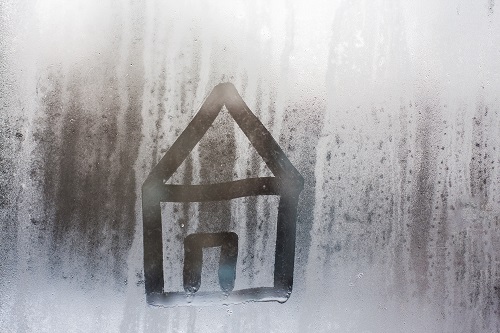Autumn is a wonderful transitional season where we start to see the back of summer and move towards cosy nights in, woolly jumpers and the glorious changing of the leaves. As the days get shorter and the temperature takes a dip, Autumn can start to affect our health in varying ways. Nobody likes getting sick but with a little bit of care, you’ll be able to dodge most of the pitfalls of the colder months.
Moisture and mould indoors
 Drying clothes indoors is something many of us have to do at some time or other and tends to be more of an issue in autumn and winter when the reduced amount of sunlight means hanging clothes on the washing line is less viable. Tempting as it may be to hang your wet socks over radiators, this releases moisture into your home and can encourage mould to grow which can release fungal spores, damaging the lungs of anyone who breathes them in. When you consider that almost 2 litres of water can be present in a load of wet washing, it’s no wonder that many homes suffer from damp and condensation. However, for many of us, drying clothes indoors is a necessary evil, so keep the room well ventilated with an open window and close the door off to the rest of the house. To prevent condensation from gathering on your windows a good tip is to keep the temperature of your home at a constant level which prevents areas of warm and cool air meeting, allowing droplets to form. Fitting wall mounted electric radiators can help as their modern digital thermostats maintain temperatures accurately and give users the freedom to set specific levels of heat. Just remember not to dry your socks on them!
Drying clothes indoors is something many of us have to do at some time or other and tends to be more of an issue in autumn and winter when the reduced amount of sunlight means hanging clothes on the washing line is less viable. Tempting as it may be to hang your wet socks over radiators, this releases moisture into your home and can encourage mould to grow which can release fungal spores, damaging the lungs of anyone who breathes them in. When you consider that almost 2 litres of water can be present in a load of wet washing, it’s no wonder that many homes suffer from damp and condensation. However, for many of us, drying clothes indoors is a necessary evil, so keep the room well ventilated with an open window and close the door off to the rest of the house. To prevent condensation from gathering on your windows a good tip is to keep the temperature of your home at a constant level which prevents areas of warm and cool air meeting, allowing droplets to form. Fitting wall mounted electric radiators can help as their modern digital thermostats maintain temperatures accurately and give users the freedom to set specific levels of heat. Just remember not to dry your socks on them!
Heart Disease and Arthritis
A fact that you may not know is that the risk of heart failure increases in the colder months. Drops in temperature can pose health risks as the heart has to work harder to keep the rest of the body warm. This increases heart rate and blood pressure, which can be dangerous for anyone particularly vulnerable. Similarly, the combination of the cold weather and atmospheric pressure changes can also be a problem for those with arthritis. An easy way of preventing both ailments is to keep your home warm and stay active indoors to raise your body temperature and to flex your joints, preventing them from stiffening up. It is advised for those with heart conditions to keep the temperature at home to at least 18 °C in order to stay safe. In places that see a lot of use such as the living room or bedroom, installing slimline electric radiators can be an excellent way of giving users control over their heating and offers a more precise and consistent level of warmth over electric blankets and hot water bottles at night.
Seasonal Affective Disorder
 It’s natural for us to be affected by the weather. A hot, sunny day can bring us a sense of optimism and energy, whereas torrential rain and dark skies remind us of more negative emotions. For the majority of the time, these feeling are fleeting and pass as soon as the weather changes but for those suffering with seasonal affective disorder (SAD), this is a different story. From September to February people with SAD will experience a severe mood change brought about by the decreased amount of daylight. Though the exact trigger for SAD is unknown, it is thought that the lack of exposure to natural light and body clock disruption are the main causes. Symptoms of SAD include loss of energy, anxiety, sleep problems and low mood, all of which can be severe enough to hinder day-to-day life. Light boxes simulating natural light are an effective and readily available treatment so if you are experiencing any of these symptoms during the colder seasons, a GP will be able to advise you on a course of action.
It’s natural for us to be affected by the weather. A hot, sunny day can bring us a sense of optimism and energy, whereas torrential rain and dark skies remind us of more negative emotions. For the majority of the time, these feeling are fleeting and pass as soon as the weather changes but for those suffering with seasonal affective disorder (SAD), this is a different story. From September to February people with SAD will experience a severe mood change brought about by the decreased amount of daylight. Though the exact trigger for SAD is unknown, it is thought that the lack of exposure to natural light and body clock disruption are the main causes. Symptoms of SAD include loss of energy, anxiety, sleep problems and low mood, all of which can be severe enough to hinder day-to-day life. Light boxes simulating natural light are an effective and readily available treatment so if you are experiencing any of these symptoms during the colder seasons, a GP will be able to advise you on a course of action.
Sore throats and Asthma
Moving from extremes of heat can aggravate those with sensitive respiratory systems and, unfortunately, it’s hard to avoid. Going from the icy outdoors into a well-heated office can affect the body negatively as it struggles to adapt from one extreme to the other in a short space of time. Those with asthma should be particularly careful as going out into the cold air can exacerbate symptoms, leading to breathlessness and wheezing. If you find you’re susceptible to fluctuating temperatures, try to stay indoors for as long as possible and only go out when necessary. Asthma sufferers should keep an inhaler within easy access at all times to minimise risk.
Many of the things you can do to keep well during the wetter months are common sense: wear appropriate clothing, don’t let yourself get too cold and wash your hands to reduce the risk of picking up germs from others. Though the weather might be getting colder, this shouldn’t prevent you from having fun during the events and holidays leading up to the end of the year, even if you have to celebrate indoors. Wrap up warm, take good care of yourself and don’t let the downturn in the weather spoil your fun.





